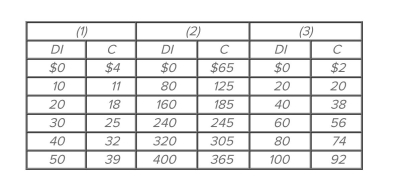Multiple Choice
 Refer to the given consumption schedules. DI signifies disposable income and C represents consumption expenditures. All figures are in billions of dollars. Suppose that consumption decreased
Refer to the given consumption schedules. DI signifies disposable income and C represents consumption expenditures. All figures are in billions of dollars. Suppose that consumption decreased
By $2 billion at each level of DI in each of the three countries. We can conclude that the
A) marginal propensity to consume will remain unchanged in each of the three countries.
B) marginal propensity to consume will decline in each of the three countries.
C) average propensity to save will fall at each level of DI in each of the three countries.
D) marginal propensity to save will rise in each of the three countries.
Correct Answer:

Verified
Correct Answer:
Verified
Q76: <span class="ql-formula" data-value="\begin{array} { | c |
Q77: <span class="ql-formula" data-value="\begin{array} { | l |
Q78: The fraction, or percentage, of total income
Q79: <span class="ql-formula" data-value="\begin{array} { | l |
Q80: Given the expected rate of return on
Q82: If for some reason households become increasingly
Q83: <img src="https://d2lvgg3v3hfg70.cloudfront.net/TB8601/.jpg" alt=" Refer to the
Q84: <img src="https://d2lvgg3v3hfg70.cloudfront.net/TB8601/.jpg" alt=" Refer to the
Q85: Assume the economy's consumption and saving schedules
Q86: If the MPC is 0.70 and investment